
Between March 2020 and March 2021, the federal government distributed an unprecedented amount of money to American public schools to address the challenges of the Covid-19 pandemic. About $6 billion was distributed in three waves to the state of Michigan alone. This report uses data provided by districts to the state government to analyze how public schools in Michigan have reported spending their Covid relief funds. This financial information covers the three school years that ended in 2020, 2021 and 2022. The analysis finds that school districts reported spending about $2.5 billion of their $6 billion in Covid aid through the 2021-22 school year. The data generally show that districts allocated this extra revenue similarly to the way they typically spend resources — with about half devoted to employee compensation, a third for purchased services and supplies and the rest on capital costs and a variety of relatively minor expenses.
Between March 2020 and March 2021, the federal government distributed an unprecedented amount of money to American public schools to address the challenges of the Covid-19 pandemic. About $6 billion was distributed in three waves to the state of Michigan alone. These funds came with great discretion on how they could be spent, and schools had wide latitude in how to document their spending.[1]
The financial support started when Congress passed the Coronavirus Aid, Relief and Economic Security Act in March 2020. The aim was to provide schools “with emergency relief funds to address the impact that COVID-19 has had, and continues to have,” according to the U.S. Department of Education.[2] Michigan schools received more than $700 million through this funding. In December 2020, Congress passed a second wave of relief, called the Coronavirus Response and Relief Supplemental Appropriations Act. Public schools received nearly $1.5 billion more. The third and final financial support package, called the American Rescue Plan Act, passed in March 2021. It topped them all, handing Michigan schools $3.7 billion in extra funding.[3]
The U.S. Department of Education said this funding was aimed at helping districts “reopen schools safely, maximize in-person instructional time, and address the impact of the Covid-19 pandemic on students, educators, and families.”[4] Allowable uses range from addressing students’ social, emotional and academic needs to dealing with health and safety concerns. More specific examples include “improving ventilation and implementing illness prevention strategies” and ”preventing teacher layoffs; providing accelerated learning opportunities; implementing rigorous curricula; funding additional counselors, school nurses, and school psychologists; increasing the number of full-service community schools.”[5] For the third and largest installment of ESSER, school districts were directed to allocate at least 20% of funds to address learning loss through evidence-based interventions such as summer programs, extended school days, or after-school programs. The remaining 80% was to be allocated at the district’s discretion subject to the allowable uses established by previous relief grants.[6]
This report uses data provided by districts to the state government to analyze how public schools in Michigan have reported spending their Covid relief funds. This financial information covers the three school years that ended in 2020, 2021 and 2022. The analysis finds that school districts reported spending about $2.5 billion of their $6 billion in Covid aid through the 2021-22 school year. The data generally show that districts allocated this extra revenue similarly to the way they typically spend resources — with about half devoted to employee compensation, a third for purchased services and supplies and the rest on capital costs and a variety of relatively minor expenses.
All Michigan school districts receiving Covid relief money are required to submit a spending plan to the Michigan Department of Education and publish it online. Each plan must explain how the funds support Covid prevention strategies, overcome the impacts of lost instructional time and address the needs of all students. Districts may respond in narrative form, meaning they do not necessarily need to provide an itemized or detailed account of how they plan to use these funds.[7]
With these rather weak reporting requirements, there is wide variation in detail among district Covid relief spending plans. For example, some school districts provide quite a few details, like those in Detroit and Dearborn. These districts published their Covid relief expenditures by fiscal year and category.[*] Detroit’s seven delineated categories include bringing students back to school, maximizing safe learning, meeting the needs of students and employees, upgrading schools and facilities management. Similarly, the Grand Rapids and Kalamazoo public school districts identify Covid relief spending by both category and grant source.[8] Across those districts that share their spending plans, we see a wide variety of uses ranging from hiring a full-time nurse to overhauling HVAC systems.
Unfortunately, these districts serve as the exception and not the rule. A considerable number of school districts report only the bare minimum required by MDE.[9] These narrative responses — published by the department in a 1,000-page document — answer only four brief questions and make determining how these districts plan to spend their Covid funds difficult.[10]
Considering that billions of dollars are at stake and given the varying levels of transparency, it’s no wonder that concerned Michigan residents want to follow this money trail. News headlines report several types of queries that concerned citizens and stakeholders have made. Additional facts were requested regarding ways that the $6 billion could be spent, how schools ought to spend the money and how the funds have already been spent.
Bridge Michigan, for example, interviewed several school leaders from five Michigan communities about how their federal funds are being spent. Answers include using funds for summer school programs, electrostatic disinfection machines, purchasing technology for classrooms and for teacher training, tutoring, supporting students’ social and emotional development, textbooks, student transportation, and counselors.[11]
Overall, news outlets have highlighted the many ways Covid relief funds could be used in support of beleaguered students, schools and families. Some reports are hopeful, some are speculative, and many are highly informative.[†]
Further complicating matters, an article by Education Next highlights the fact that numerous school districts developed their spending plans before they understood the severity and nature of learning losses sustained during school closures. Districts may alter their spending plans and are allowed to conduct ex post facto revisions of their spending plans. This would allow districts that formerly prioritized things like facilities, labor costs or third-party services to combat learning losses instead. Authors Katherine Silberstein and Marguerite Roza aptly stated: “What facilities investments aren’t doing, however, is resolving gaps in learning which are at the heart of what most see as the purpose of relief funds.”[12] The bottom line is that it is difficult to tell the extent to which schools are using the billions of dollars in Covid relief to buttress their infrastructure and operational status quo versus providing additional and targeted services to struggling students.
Direct inquiries of districts on this question have not yielded much helpful information. Investigators from The Center Square issued public record requests to school districts across the state. Reporter Scott McClallen confirmed that only 25% of school districts responded to his requests.[13] Ideally, all districts would publish the amount of Covid relief expended to date, detail how the money was spent and outline intended uses for remaining funds.
After years of conjecture about how districts are spending their unprecedented relief money, enough information has accumulated to get at this question. Michigan’s Center for Educational Performance and Information has released three years’ worth of state and district-level expenditure data. Spending is categorized by fund, function and source, allowing us to pull back the veil and move beyond narratives and testimonials from school officials. These data allow us to determine how much money has been spent and more precisely understand where it is going.
[*] Dearborn makes available spreadsheets that show how the district spent each of the Covid-related federal grants it received. These are available here: https://dearbornschools.org/ budgettransparency. Detroit posted detailed plans for how it was to spend its relief funds, see: https://perma.cc/G8MW-ANA9.
[†] For examples, see: Jennifer Chambers, “Michigan’s plan for federal COVID relief funds for schools approved” (The Detroit News, Oct. 8, 2021), https://perma.cc/25LQ-CLEM; Lily Altavena, “Some Michigan schools try to steer COVID cash to athletics, security cameras” (Bridge Michigan, April 11, 2022), https://perma.cc/UYA7-A2TN; Koby Levin, “How COVID-19 cash could help Michigan schools tackle a mental health crisis” (Detroit Free Press, March 14, 2022), https://perma.cc/N92Q-7E62; Koby Levin and Ethan Bakuli, “Federal COVID relief aid to schools will dry up soon. Are districts ready?” (Chalkbeat Detroit, Feb. 17, 2023), https://perma.cc/K5BL-YFRW.
From 2020 to 2022, Michigan public schools spent $86 billion in total, including their Covid relief funds. Graphic 1 shows that, from year to year, school districts spent the most money on employee salaries, benefits and “other expenditures,” which includes “dues and fees, interest on debt, claims and judgements, miscellaneous, and “other financing and debt.” Employee compensation — including salaries and benefits — consumed half of all spending.
The main catalyst for increased statewide spending — despite a 4.3% enrollment decline since the 2018-19 school year — was the enormous amount of federal Covid aid doled out over this period.[14] Of the $86 billion spent by Michigan public schools, $2.58 billion came from revenue related to pandemic relief.
Graphic 1: Total public school spending, 2019-2022
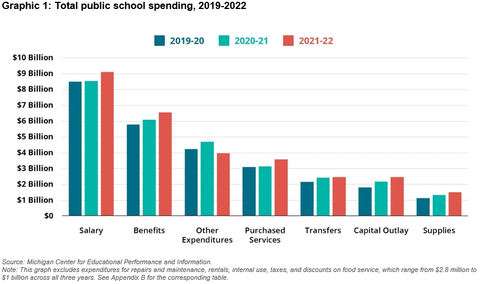
Source: Michigan Center for Educational Performance and Information.
Note: This graph excludes expenditures for repairs and maintenance, rentals, internal use, taxes, and discounts on food service, which range from $2.8 million to $1 billion across all three years. See Appendix B for the corresponding table.
The graphic also shows an increase in spending over these three years. Michigan schools spent progressively more money in every category except on “other expenditures.” Between 2019-20 and 2021-22, spending increased overall by 11%, or $2.99 billion. While employee salaries and benefits, at $1.35 billion, represent the largest dollar value increase, spending on compensation increased by 9%, slightly less than the overall average.
Spending in other categories grew faster, such as capital outlay and supplies, which grew by 37% and 34%, respectively. Over these three school years, purchased services and repairs and maintenance expenditures also increased more than employee compensation, jumping up by about 16% in each category. This broad view suggests that Michigan schools, on average, used their Covid relief funds to hire more employees, increase compensation, purchase more supplies and services from third parties, and make building improvements.
Never have Michigan public schools received such large sums of money in such a short amount of time as they did through federal Covid relief funds. Not only that, but school officials also have broad discretion on how to spend these additional resources. The main requirement is that the money be allocated in a certain amount of time — although it’s not clear what penalty would be enforced for districts that do not spend this money by a certain date.
Most school districts are challenged with spending a lot of money fast. The expenditure data from Michigan’s Center for Educational Performance and Information allow for a closer look at how schools have used this money so far. Table 1 shows the statewide totals of how school districts reported spending their Covid relief funds from the last three school years: 2019-20, 2020-21 and 2021-22. This funding came from 19 Covid-related grants, which are listed in Appendix A.
Altogether, school districts spent $2.58 billion of their Covid funds across these three school years. This constitutes about half of the total Covid aid granted to Michigan school districts. Districts have until September 2024 to spend the remaining funds.
It should be noted that funds were not distributed equally across school districts. Those serving a greater number of students from low-income households received significantly more dollars per pupil. Urban school districts received more money per pupil, in general, than districts located in suburban communities or small towns. Some districts, such as Flint, Detroit and Pontiac, received tens of thousands of dollars extra per student. Other districts, such as East Grand Rapids, DeWitt and Brighton, received just hundreds of dollars per student in Covid relief.[15]
Graphic 2: Total Covid spending by all public schools by category and year
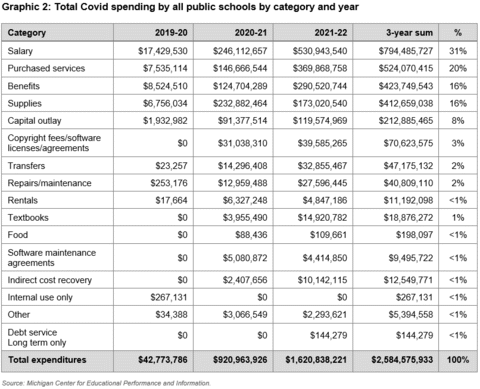
About half of all education spending from 2020 to 2022 covered employee salaries and benefits. That is a well-documented, long-term trend in school finance: districts typically devote about half or more of their budgets to employee compensation. It is, however, interesting that almost the same percentage of Covid relief was spent on compensating employees. Across all three years, employee salaries and benefits made up 47%, or $1.2 billion, of total pandemic relief expenditures.
One plausible reason schools might spend such a large amount of pandemic relief on employee compensation is to hire new employees to address learning losses. State data show, however, that staffing levels did not increase significantly over this period. This suggests that schools used their Covid relief funds to boost the pay of existing employees rather than hire more of them.
State data show staffing trends for the number of full-time equivalent employees.[16] Between fall 2019 and fall 2022, overall staffing levels at schools increased by 5,800, or 3%. Most of that increase happened between 2021 and 2022, with districts adding nearly 5,000 employees in just one year. Even if each new employee hired by school districts cost an average of $100,000, that would amount to less than half of the Covid relief funds districts spent. A rough estimate then would be that districts have spent at least a quarter of all Covid relief so far on boosting the pay of existing employees.
Looking at the staffing changes by job category reveals that, in the years since Covid broke out, most growth occurred in the number of instructional coordinators, district-level administrators and administrative staff. Districts hired the equivalent of 666 new full-time instructional coordinators between 2019 and 2022, a more than 50% increase. They hired 1,198 more district administrators and administrative staff over the same period, an increase of 30%. On average, districts hired at least one new coordinator and two new district-level administrative employees.[*]
The number of teachers remained somewhat level, with an increase of 1% for all general education, special education and career and technical education teachers. That represents about 990 teachers. Interestingly, schools hired large numbers of career and technical teachers since 2019. Although the total number is small, with only 2,000 employed in 2022, staffing levels for career and technical teaching personnel have increased by 22% in three years and made up a third of the increase in teacher hirings over the period.
Overall, staffing levels did not increase drastically enough to suggest that the $1.2 billion of Covid aid slated for compensation was primarily devoted to mitigating learning losses incurred by prolonged school closures. With the additional $1.2 billion, Michigan school districts could have hired roughly 16,300 more full time-employees.[†] Although a portion of the funds may have been used to hire new employees, these findings support the idea that school districts mostly used Covid relief funds to pad existing employees’ compensation levels.
Graphic 3 shows the spending allocation of Covid relief funds for school years ending in 2020, 2021 and 2022. There are 15 different categories in which districts can report spending. More than 90% of all pandemic relief spending fell into just four of those categories: employee compensation, purchased services, supplies and capital expenses. As mentioned, the portion devoted to compensation was similar to the share allocated by districts in the year before Covid. But a much larger proportion of pandemic relief was spent on supplies (11% greater share) and purchased services (8% greater share) relative to 2018-19 allocations. In other words, school districts spent a greater proportion of Covid aid on purchased services and supplies than was spent in years prior to the pandemic. The increased spending on supplies and purchased services could represent efforts by districts to address learning loss and mitigate the effects of school closures, but it is difficult to determine more than this based on this data.
Graphic 3: Total Covid spending by all public schools in category percentages, 2019-2022
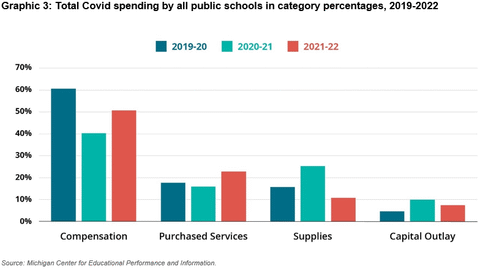
The increase in purchased services is particularly stark. This spending is when school districts contract with third-party vendors to provide services, such as pupil transportation, food service, building maintenance, administrative and personnel services and more. Twenty percent of Covid aid funded purchased services, which is nearly double the portion school districts normally spend on purchased services (11%). This trend suggests that school districts relied on third-party vendors to meet acute needs during the pandemic.
Similarly, districts spent three times the portion they normally spend on supplies. They devoted 16% of Covid relief to supplies, whereas they typically spend just 5% of their funds for this purpose. Supplies can include educational media, energy costs, hardware and tools, periodicals, testing materials and transportation supplies.
Schools spent the most on supplies in the second year of their Covid relief. In 2020-21, districts devoted 25% of all Covid relief to supplies, or $230 million. Of this, 60% was categorized as miscellaneous and 36% as teaching and testing materials.
A more granular analysis shows that, during that school year, 61% of pandemic funding for miscellaneous supplies was spent on “operating buildings services,” which includes heating, lighting, and air systems; repairing facilities and equipment; building leases; property and liability insurance; and janitorial and ground maintenance costs. About 10% covered “non instructional technology,” such as supporting networks, maintaining information systems, processing data, supervising technology personnel and hardware. This spending may reflect schools’ attempt to improve their facilities and technology in order to operate virtual learning courses and flexible scheduling for in-person classes.
[*] Despite this increase in hiring district-level administrators, the total number of administrative employees at school districts decreased slightly from fall 2019 to fall 2022. Including school-level administrators and support staff and school and district directors in the tally finds the total number of administrators fell by 179, a 0.7% decrease. The most significant decrease was in school-level administrators, whose numbers fell by 1,771, or 27%.
[†] This calculation is based on the average cost per employee which is determined by dividing the total amount districts spent on employee compensation by the number of full-time school employees districts employed during the 2018-19 school year.
According to the Michigan Association of Public School Academies, 295 charter schools serve more than 10% of Michigan’s students.[17] Given the differences between district- and charter-run schools in facilities and governance, among other things, we conduct an expenditure analysis by school type to identify if these sectors allocated their Covid relief differently. Since there were systematic differences in how these different types of schools reported their Covid relief spending, this analysis provides a clearer picture of how both sectors — conventional school districts and charter schools — allocated their respective resources.
Compared to conventional school districts, charter schools reported using a larger portion of their Covid relief on purchased services and supplies. For the three school years starting in 2019, 2020 and 2021, charter districts spent 69% on purchased services and 16% on supplies. Only 4% went to labor costs.
Many of these differences can be explained by the way charter schools operate. Instead of hiring their own staff, most charter schools pay a management company to handle their staffing needs. The related expenses, including employee compensation, gets categorized as a purchased service. This is a limitation of the spending data that makes it difficult to tell if charters allocated their resources differently than school districts.
Isolating data for conventional districts shows that they spent a slightly larger share on labor costs than the overall data suggest. Over the three years analyzed, districts spent 52% of their pandemic relief on labor. They spent the same portion as charters on supplies — 16%. This analysis also shows that districts spent only 15% on purchased services, which is more than they typically spend, but not as much of an increase as the aggregated data suggest.
It is possible to dig deeper into the data to see how charter schools categorized their purchased service spending of Covid relief. We compared the way charter schools allocate regular funds and Covid aid within the purchased services category during the 2021-22 school year. Specifically, we analyze how funds are apportioned within the purchased services subcategory, called professional technical services. This covers 95% of spending by charter schools on purchased services.
Charter schools reported allocating 49% of their regular education funds on instructional services, 23% on management services and 11% on “other.” For Covid-related grants, 71% were used for instructional services, 5% for management services and 10% for “other.” Instructional services are performed by professionals who provide learning experiences for students, including teaching and paraprofessional activities. Management services are provided to assist management in a broad policy area or general operation of the school system. Charters devoted a greater proportion of pandemic relief for instructional services and a smaller portion for management services. This suggests that charter schools focused a sizable portion of their Covid relief on addressing learning losses and other achievement gaps that may have been caused by school closures and instructional interruptions during these pandemic years.
Further evidence to this effect shows up in how charter schools categorized the portion of spending that went to purchased instructional services. Charters designated a larger share of Covid relief (8%) for compensatory education than they did with regular education funds. This suggests that, in the face of major disruptions in the classroom, charter schools shifted some of their spending focus to addressing the learning gaps brought on by the pandemic.
This analysis addresses how Michigan school districts reported spending the $2.5 billion in Covid aid they received from 2020 through 2022. It addresses the dearth of information regarding the use of federal relief funds by analyzing state- and district-level expenditure data.
Across all three years, a total of $1.2 billion of Covid relief funded employee compensation. School districts did not primarily use this money to hire additional staff for student support. Rather, it appears they mostly used it to buttress the salaries and benefits of existing employees. Districts did spend more than normal on supplies and purchase services, both of which could have been used to deal with some of the effects of the pandemic on students.
Second only to labor costs, school districts spent the most Covid relief on purchased services and supplies. They used a greater proportion of Covid funding for these two categories than they normally devote to such expenditures. This suggests that the increased spending in these categories was an attempt to deal with issues arising from pandemic policies, such as school closures, forced quarantines, etc.
Charter schools appear to have spent their Covid relief funds somewhat differently, although there are limits to interpreting the data. Charters prioritized the use of Covid relief funds for additional instructional services, particularly compensatory activities. This suggests that charters focused some of these extra resources on mitigating the learning disruptions brought on by the pandemic.
The degree to which any of these efforts have helped students overcome learning loss and stabilize the classroom is difficult to quantify. Nevertheless, district and school leaders are still charged with the responsibility of shepherding their staff and students through a time of great disruption. And, while dollars spent do not always translate to success, following the money trail is one of the first steps we can take to determine what districts did to help students and to quantify the impact of such efforts.
All school districts must be held accountable to ensure that they did, in fact, allocate at least 20% of their funds to address deficits in student learning. With only half the money spent and one school year left to spend the remainder, there is still time for districts to dispense the rightful amount of Covid aid in support of closing these gaps. More robust reporting mechanisms will be needed to assess this. Especially since a designated portion of relief funds were specifically allocated for administering these monies, expectations of stronger reporting should not be too much to hope for.
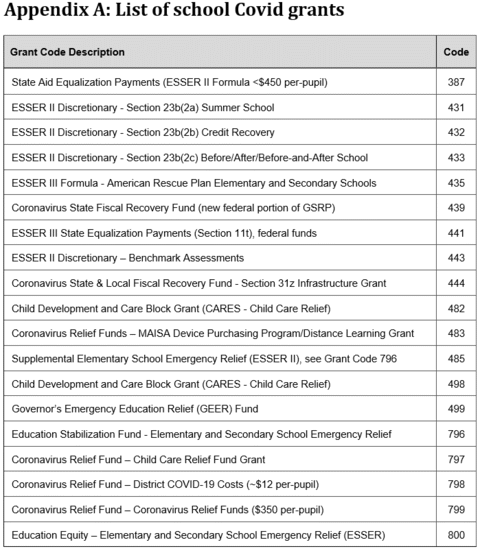
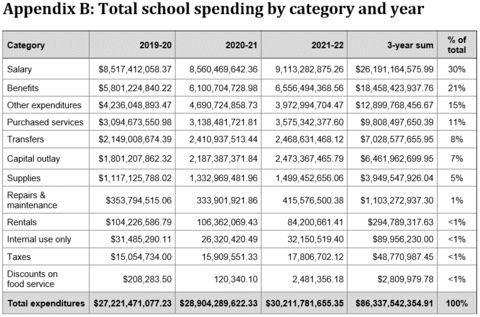

1 Ben DeGrow, “Adding Up the Extra COVID-19 Funding for MIchigan Public Schools” (Mackinac Center for Public Policy, April 20, 2021), 3, https://www.mackinac.org/S2021-01.
2 ”Elementary and Secondary School Emergency Relief Fund” (U.S. Department of Education, Sept. 13, 2021), https://perma. cc/DA8C-F7EX.
3 Ben DeGrow, “Adding Up the Extra COVID-19 Funding for MIchigan Public Schools” (Mackinac Center for Public Policy, April 20, 2021), 5, https://www.mackinac.org/S2021-01.
4 ”Frequently Asked Questions: Elementary and Secondary School Emergency Relief Programs Governor’s Emergency Education Relief Programs” (U.S. Department of Education, Dec. 7, 2022), 10, https://perma.cc/E6S6-Z3BS.
5 ”Frequently Asked Questions: Elementary and Secondary School Emergency Relief Programs Governor’s Emergency Education Relief Programs” (U.S. Department of Education, Dec. 7, 2022), 11, https://perma.cc/E6S6-Z3BS.
6 ”Fact Sheet: American Rescue Plan Act of 2021: Elementary and Secondary School Emergency Relief Fund (ARP ESSER)” (U.S. Department of Education), https://perma.cc/SH5A-SLDJ.
7 Kyle L. Guerrant, ”Memorandum: Section 11t Equalization Application Availability” (MIchigan Department of Education, March 17, 2022), 3-5, https://perma.cc/G7JZ-687M.
8 Rhonda A. Kribs, “Covid Funding Update” (Grand Rapids Public Schools, Sept. 12, 2022), https://perma.cc/BG3T-RFHL; “ESSER III Spending Plan” (Kalamazoo Public Schools, Dec. 2, 2021), https://perma.cc/V6U7-KWQ9.
9 Kyle L. Guerrant, ”Memorandum: Section 11t Equalization Application Availability” (MIchigan Department of Education, March 17, 2022), https://perma.cc/G7JZ-687M.
10 “American Rescue Plan 2021” (Michigan Department of Education, Feb. 25, 2022), https://perma.cc/W4XR-WLEW.
11 Tracie Mauriello, “How Michigan schools are spending $6 billion in federal COVID relief” (Bridge Michigan, Aug. 16, 2021), https://perma.cc/KK8S-5DAT.
12 Katherine Silberstein and Marquerite Roza, “The Massive ESSER Experiment: Here’s what we’re learning.” (Education Next, April 4, 2023), https://perma.cc/R7YM-TSWS.
13 Scott McClallen, “Some Michigan schools keep mum on COVID relief spending” (The Center Square, Sept. 19, 2022), https://perma.cc/HX7Z-QLRF.
14 “Student Enrollment Counts Report” (MI School Data), https://perma.cc/97AS-J4T7.
15 John Wisely, “Michigan schools to get $6B in COVID-19 funding: Here's how much your district will get” (Detroit Free Press, March 31, 2021), https://perma.cc/J7V8-7GPZ.
16 “Additional Staffing Data Files” (Michigan Center for Educational Performance and Information), https://perma. cc/T2AZ-4UV5.
17 “Michigan’s Charter Schools” (Michigan Association of Public School Academies, 2023), https://perma.cc/4XCM-WDTM.